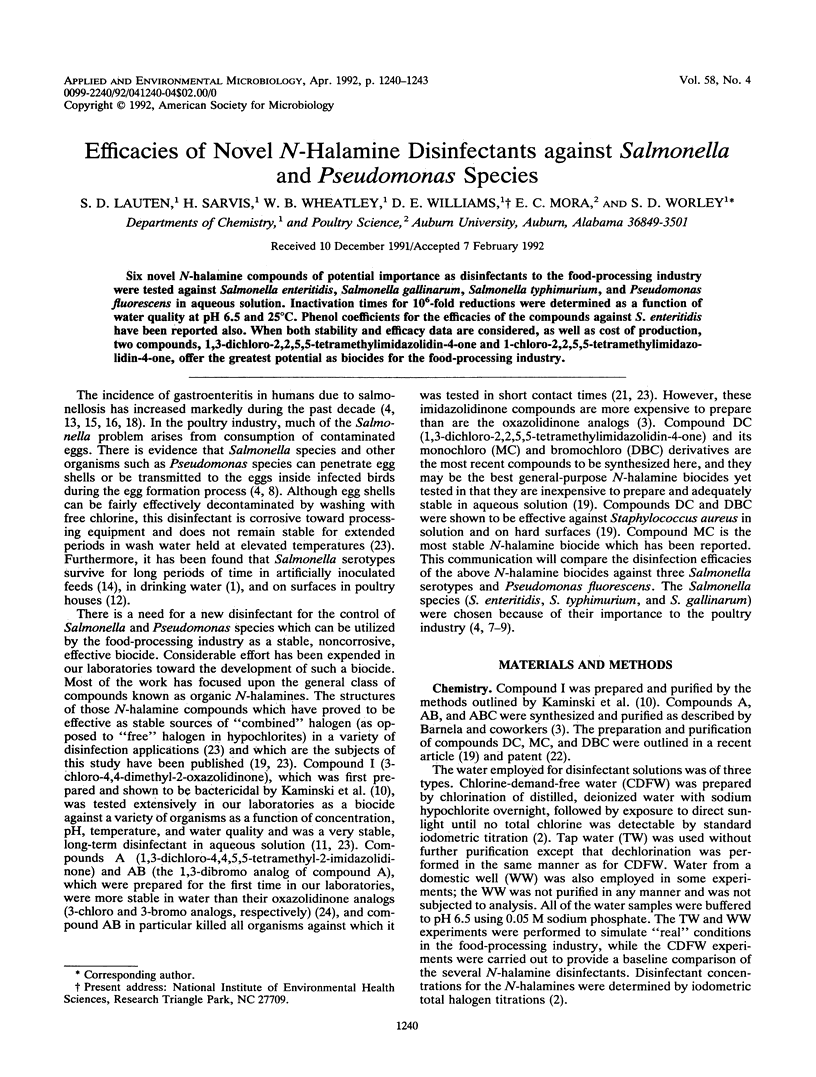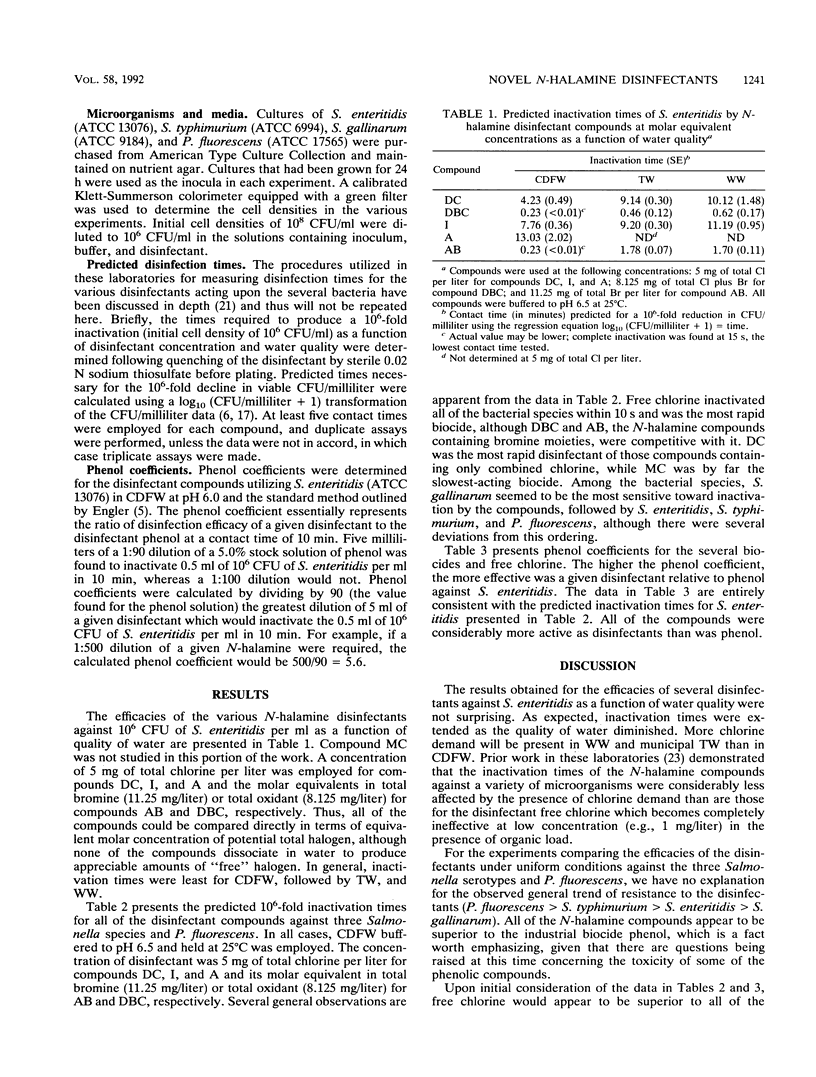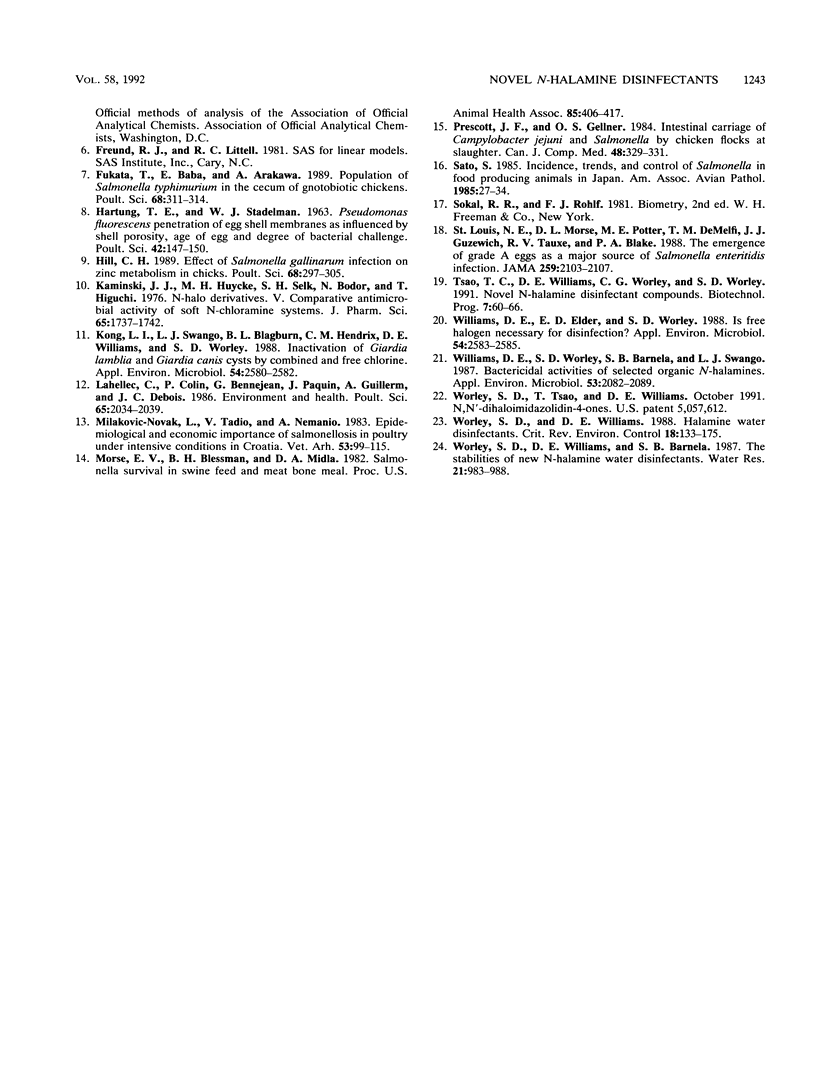Abstract
Six novel N-halamine compounds of potential importance as disinfectants to the food-processing industry were tested against Salmonella enteritidis, Salmonella gallinarum, Salmonella typhimurium, and Pseudomonas fluorescens in aqueous solution. Inactivation times for 106-fold reductions were determined as a function of water quality at pH 6.5 and 25°C. Phenol coefficients for the efficacies of the compounds against S. enteritidis have been reported also. When both stability and efficacy data are considered, as well as cost of production, two compounds, 1,3-dichloro-2,2,5,5-tetramethylimidazolidin-4-one and 1-chloro-2,2,5,5-tetramethylimidazolidin-4-one, offer the greatest potential as biocides for the food-processing industry.
Full text
PDF



Selected References
These references are in PubMed. This may not be the complete list of references from this article.
- Al-Chalaby Z. A., Hinton M. H., Linton A. H. Failure of drinking water sanitisation to reduce the incidence of natural salmonella in broiler chickens. Vet Rec. 1985 Apr 6;116(14):364–365. doi: 10.1136/vr.116.14.364. [DOI] [PubMed] [Google Scholar]
- Barnela S. B., Worley S. D., Williams D. E. Syntheses and antibacterial activity of new N-halamine compounds. J Pharm Sci. 1987 Mar;76(3):245–247. doi: 10.1002/jps.2600760314. [DOI] [PubMed] [Google Scholar]
- Fukata T., Baba E., Arakawa A. Population of Salmonella typhimurium in the cecum of gnotobiotic chickens. Poult Sci. 1989 Feb;68(2):311–314. doi: 10.3382/ps.0680311. [DOI] [PubMed] [Google Scholar]
- Hill C. H. Effect of Salmonella gallinarum infection on zinc metabolism in chicks. Poult Sci. 1989 Feb;68(2):297–305. doi: 10.3382/ps.0680297. [DOI] [PubMed] [Google Scholar]
- Kaminski J. J., Huycke M. M., Selk S. H., Bodor N., Higuchi T. N-Halo derivatives V: Comparative antimicrobial activity of soft N-chloramine systems. J Pharm Sci. 1976 Dec;65(12):1737–1742. doi: 10.1002/jps.2600651211. [DOI] [PubMed] [Google Scholar]
- Kong L. I., Swango L. J., Blagburn B. L., Hendrix C. M., Williams D. E., Worley S. D. Inactivation of Giardia lamblia and Giardia canis cysts by combined and free chlorine. Appl Environ Microbiol. 1988 Oct;54(10):2580–2582. doi: 10.1128/aem.54.10.2580-2582.1988. [DOI] [PMC free article] [PubMed] [Google Scholar]
- Lahellec C., Colin P., Bennejean G., Paquin J., Guillerm A., Debois J. C. Influence of resident Salmonella on contamination of broiler flocks. Poult Sci. 1986 Nov;65(11):2034–2039. doi: 10.3382/ps.0652034. [DOI] [PubMed] [Google Scholar]
- Prescott J. F., Gellner O. S. Intestinal carriage of Campylobacter jejuni and Salmonella by chicken flocks at slaughter. Can J Comp Med. 1984 Jul;48(3):329–331. [PMC free article] [PubMed] [Google Scholar]
- St Louis M. E., Morse D. L., Potter M. E., DeMelfi T. M., Guzewich J. J., Tauxe R. V., Blake P. A. The emergence of grade A eggs as a major source of Salmonella enteritidis infections. New implications for the control of salmonellosis. JAMA. 1988 Apr 8;259(14):2103–2107. [PubMed] [Google Scholar]
- Williams D. E., Elder E. D., Worley S. D. Is free halogen necessary for disinfection? Appl Environ Microbiol. 1988 Oct;54(10):2583–2585. doi: 10.1128/aem.54.10.2583-2585.1988. [DOI] [PMC free article] [PubMed] [Google Scholar]
- Williams D. E., Worley S. D., Barnela S. B., Swango L. J. Bactericidal activities of selected organic N-halamines. Appl Environ Microbiol. 1987 Sep;53(9):2082–2089. doi: 10.1128/aem.53.9.2082-2089.1987. [DOI] [PMC free article] [PubMed] [Google Scholar]


